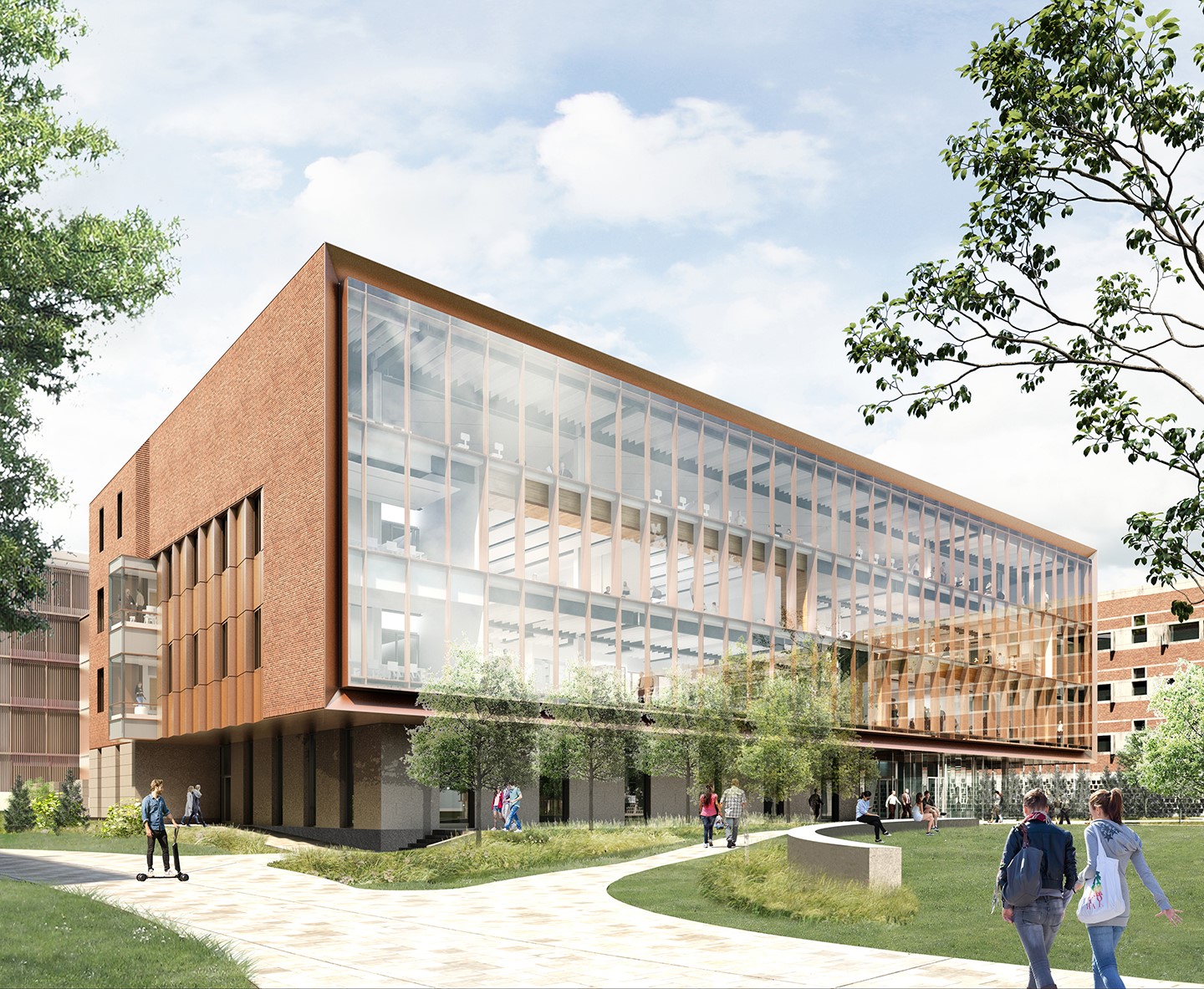HIGHLIGHTS
PROGRAM UPDATES
The AWC Updates Span Calculator to Include 2018 and Non-North American Design Values The AWC Defends Against Unfavorable Proposals During the ICC Group B Hearings The AWC, WoodWorks, USGBC Join to Highlight Mass Timber’s Carbon Benefits in LA Think Wood and University of Washington Launch Research on Mass Timber’s Impact on Forest InventoryINDUSTRY NEWS
New Think Wood-Sponsored Course Explores Linkages Between Wood Construction and Sustainability New Data Tool Aims to Help Municipalities Prioritize Carbon Actions, Including Low-Carbon Construction New Prefab Mass Timber Building System Introduced in Vancouver Construction Labor Market Remains Tight Rent-to-Own Housing Grows in Popularity, Despite Risk Texas A&M Team Creates New Flame-Retardant Coating for Wood Construction Materials 10-Story Mass Timber Building to Undergo Shake Table Testing This SummerINSIGHTS ON THE COMPETITION
New Pulp-Based Stud Enters Commercial ProductionINDUSTRY RESOUCES
Virginia Tech's Monthly Housing ReportProgram Updates
The AWC Updates Span Calculator to Include 2018 and Non-North American Design Values
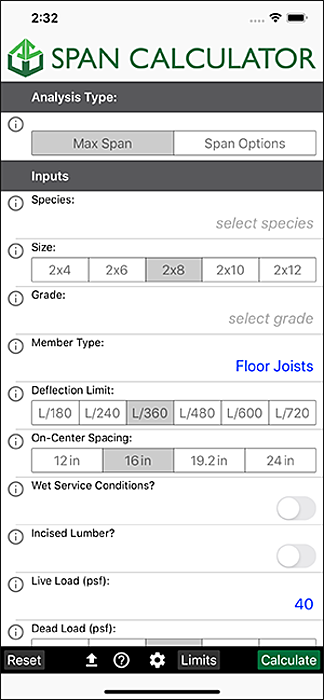
The AWC updated its mobile app and web-based Maximum Span Calculator for Wood Joists and Rafters to include the design values found in the Supplement to the 2018 National Design Specification® (NDS®) for Wood Construction (NDS-2018) as well as design values for non-North American species. This release brings the AWC’s most popular calculator up to date with the latest codes, helping designers, plan reviewers, and code officials save time when checking spans for proposed lumber-floor joists, ceiling joists, and rafters.
In addition, the calculator’s “span options” mode allows users to select multiple species and grades for comparison. This feature, along with the addition of non-North American design values, will help lessen confusion regarding the acceptance and proper use of European lumber, avoiding costly and time-consuming misinterpretations such as those that occurred last year in North Carolina.
The updated AWC Span Calculator is available on the AWC website and in the Android, iOS, and Windows app stores.
The AWC Defends Against Unfavorable Proposals During the ICC Group B Hearings
Multiple proposals that could be detrimental to the softwood lumber industry were raised during recent International Code Council (ICC) Group B Committee Action Hearings. During the hearings and guided by recommendations from the AWC’s Subcommittee on Codes and Product Evaluation (SCAPE), the AWC provided expert testimony against proposals to:
- Expand the wildland-urban interface (WUI) zone construction requirements to structures outside the zone being rebuilt because of wildfires. WUI zone construction requirements already limit the use of certain combustible materials, and the proposal would add cost to construction outside of designated WUI zones.
- Modify the fire resistance of platform construction when exterior walls must be fire rated by code. The AWC’s existing design documents provide solutions to allow for the continued acceptance of platform construction without adding unnecessary cost.
- Require decks to be engineered to resist lateral loads, such as side-to-side motion from occupants, without providing details on how loads would be determined. This change is a maneuver to make on-grade exterior living a more attractive alternative to decks.
- Require that certain materials not exceed embodied carbon limits and/or have environmental product declarations (EPDs) for a percentage of material based on cost. Although industrywide EPDs are available for wood products, this proposal sets an unfavorable precedent for expanding the scope of the building code.
- Require new snow-load maps and corresponding snow loads without adequate revision of structural deflection requirements. If approved, the change would lead to oversizing of roof rafters compared with the AWC’s published span tables.
In addition to arguing against these unfavorable proposals, the AWC also submitted several wood-friendly proposals that will be considered during the hearings. Following the conclusion of the hearings, the AWC will provide a comprehensive report on changes identified as threats and opportunities.
The AWC, WoodWorks, USGBC Join to Highlight Mass Timber’s Carbon Benefits in LA
The AWC and WoodWorks teamed up on a recent webinar hosted by USGBC-Los Angeles on “The Renewal of Wood & Future of Mass Timber,” which highlighted the many positive attributes of mass timber construction and its ability to support Los Angeles in meeting its net-zero building goals. The webinar, in which a WoodWorks staffer was a featured speaker, also generated significant support for the AWC’s and others’ opposition to a current LA City Council motion to prohibit mass timber in Fire District One. The AWC and its partners are following up with several major architectural firms and the Urban Land Institute, which, because of the webinar, expressed an interest in reaching out to the City Council to provide further support for the AWC’s positions.
Additionally, the LA Council recently introduced a motion to require its Building and Safety Department, in conjunction with the Office of the City Attorney and the Climate Emergency Mobilization Office, to report back within 180 days with an ordinance or regulatory framework that would require new residential and commercial buildings in LA to be net-zero carbon. Though the motion is focused on energy efficiency, the AWC perceives a strong opportunity to include lower-embodied-carbon building materials as a means to further reduce carbon emissions, in line with the motion’s intent.
Think Wood and University of Washington Launch Research on Mass Timber’s Impact on Forest Inventory
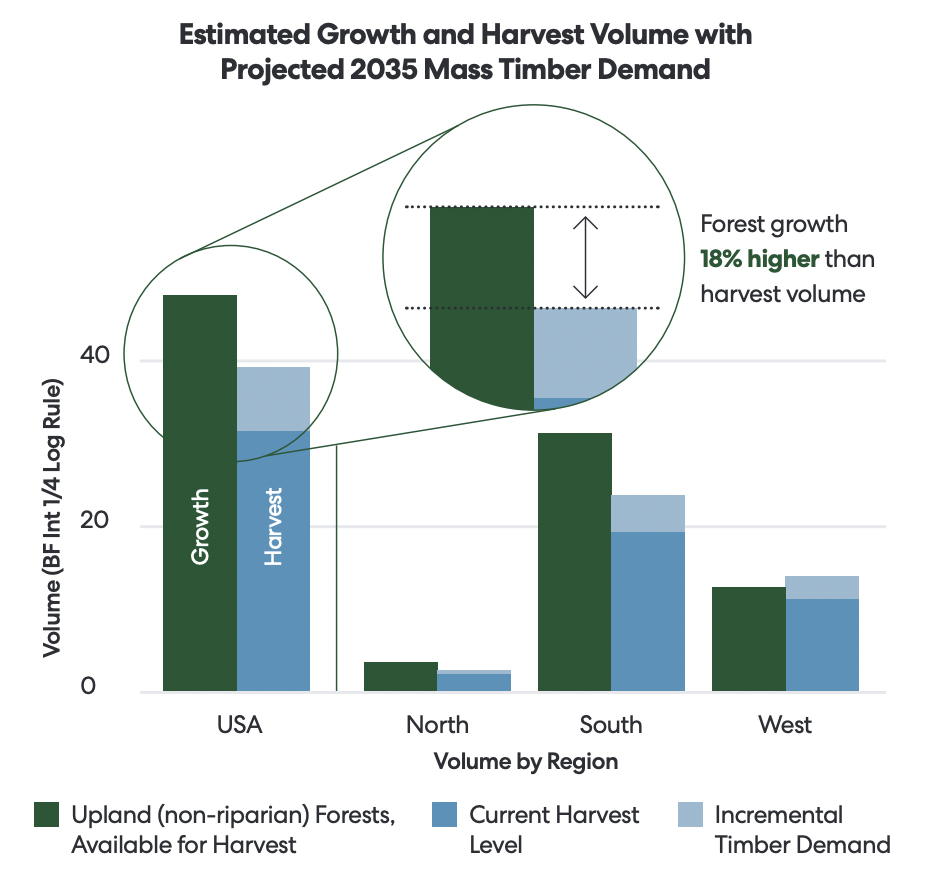
In 2021, Think Wood, with Binational Softwood Lumber Council funding, sought to answer a pressing question from architects, engineers, construction professionals, and other stakeholders: Will rising demand for mass timber products result in unsustainable levels of harvesting in coniferous forests in the United States? The answer is no.
Using USDA Forest Service Forest Inventory and Analysis (FIA) data, the study revealed that U.S. forest growth exceeds harvest levels—even in the most conservative scenario using the lowest estimate of growth and the highest estimate of harvest volumes required to meet incremental demand for both lumber and mass timber in 2035. The findings were published in the peer-reviewed journal Sustainability and were also presented during a forestry panel at the International Mass Timber Conference in April. Think Wood developed a fact sheet summarizing these findings, which has been shared with the AWC, WoodWorks, the National Alliance of Forest Owners (NAFO), and the U.S. Endowment for Forestry and Communities for distribution to their respective audiences.
Overstocked forests are vulnerable to drought, disease, and insects, making them prone to high rates of tree mortality and wildfires that are difficult to control. As part of their mass timber demand analysis, study authors also assessed areas of opportunity to sustainably increase harvesting beyond current levels by looking at underutilized growth by state, owner, and region. These sources can meet increased demand and make our forests more resilient without requiring any policy changes. These sources include privately owned forests in the South; overstocked national forests in Washington, Oregon, and California; and adding processing capacity in eastern Washington and Oregon.
Learn more by reading the findings.
Industry News
New Think Wood-Sponsored Course Explores Linkages Between Wood Construction and Sustainability
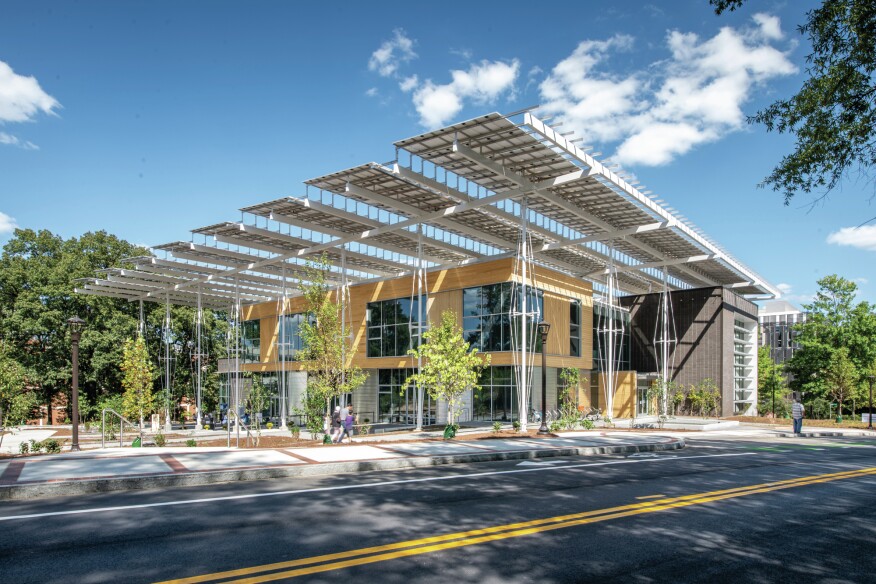
Architect Magazine has published a new on-demand continuing education unit (CEU), underwritten by Think Wood, that explores how advances in wood construction and sustainability can contribute to the built environment. The CEU examines the use of wood in sustainable design, including as part of adaptive reuses, and features a panel discussion with architects Ruth Mandl, AIA, principal of the Brooklyn, New York-based Co Adaptive Architecture, and Joshua R. Gassman, sustainable design director at Lord Aeck Sargent.
Mandl stresses sustainability as a holistic endeavor, believing that the more design professionals learn about sustainable practices, the more they will consider not only the source and manufacturing of materials, but also the people involved and the life cycle of a given material. “Although architects may believe that what they build is permanent, it’s not,” Mandl says. “How can we already plan for this impermanence now such that in the future, these buildings are easier to adapt and easier to take apart and reuse the components elsewhere?”
The recorded presentation is the first of a two-part continuing education series on advances in wood construction through the lens of sustainability and innovation.
Learn more about the CEU here.
New Data Tool Aims to Help Municipalities Prioritize Carbon Actions, Including Low-Carbon Construction
A new calculator created by Princeton University is meant to help city planners and town councils around the world identify and prioritize actions to achieve net-zero carbon dioxide emissions. The tool, called the Zero Emissions Calculator for Communities (ZECC), includes a gamut of potential actions, including mass timber construction, urban reforestation, compact development, electric heating systems, and technologies focused on increasing efficiencies in the food, waste, and energy sectors.
The Princeton team is also working to combine the ZECC tool with high-resolution local data to create a Greenhouse Gas Scenario Planning tool to quantify individual communities’ energy use and emissions. This tool is in beta testing using the Twin Cities Metropolitan Council in Minnesota as its test site.
Russ Stark, the City of Saint Paul’s Chief Resiliency Officer, said: “We’re always trying—literally month to month—to figure out the best use of our time in reducing greenhouse gas emissions. This can help us decide whether to focus more on particular transportation initiatives, or building energy initiatives, or other things.”
Anu Ramaswami, who developed the tool, pays specific attention to the carbon savings wood creates when used in place of concrete in buildings, noting that “mass timber buildings can be a phenomenal way of literally storing the forest in your building.” Ramaswami believes that designing buildings with mass timber can close cities’ carbon gaps by an estimated 10%. In addition, building more multistory buildings can result in compact urban design that maximizes travel efficiency to close the carbon gap by another 20%, creating space for urban reforestation.
Read more about ZECC and the worldwide pursuit of zero carbon here.
New Prefab Mass Timber Building System Introduced in Vancouver

The Journal of Commerce by ConstructConnect recently featured BioFrame, a prefabricated mass timber building system developed by Vancouver architect Arno Matis. Matis believes that BioFrame can offer a cost-effective solution to revitalizing buildings, particularly multifamily buildings, hotels, and possibly industrial sites, by avoiding challenges related to labor shortages, rising costs, waste, and carbon emissions.
BioFrame is unique in that it employs a method of clipping mass timber components onto existing steel or concrete structures. It can be used to retrofit older buildings by adding space to existing floors or by adding new stories. For new stories, BioFrame uses a support column system to transfer loads downward, overcoming any inability of an existing structure to bear added load.
Matis is quick to tout the benefits of BioFrame’s use of mass timber and prefabrication, which include carbon sequestration, faster construction times, and reduced costs, including by saving on demolition, removal, and recycling of waste.
Read more about BioFrame here.
Construction Labor Market Remains Tight
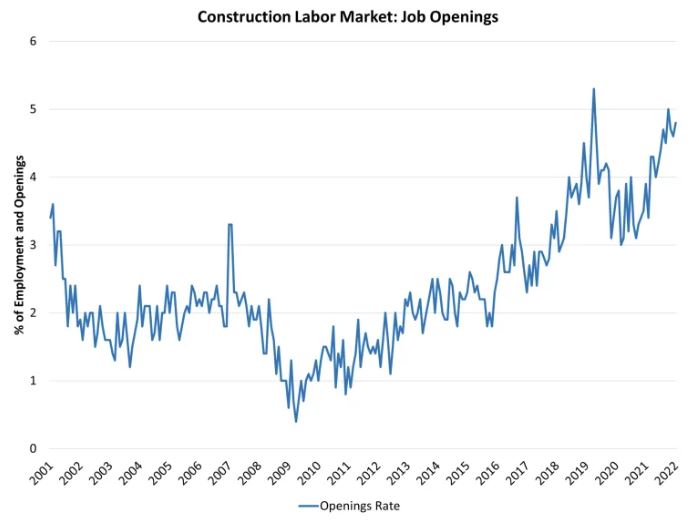
The National Association of Home Builders’ Eye on Housing released its latest data on the construction labor market, which shows a growing number of job openings year-over-year. February 2022 saw 381,000 unfilled positions, which, while steady from the previous month, is significantly higher than the 257,000 openings recorded a year ago. Hiring increased, reaching a rate of 5.2%, and layoffs remained low, at 2%. Layoffs have trended low since 2021 and reflect the industry’s skilled labor shortage.
Looking ahead, the NAHB believes that the construction job openings rate is likely to rise as both residential and nonresidential construction expand. In particular, the organization’s analysts note that the housing market remains underbuilt and requires additional skilled labor, land, lumber, and other building materials to add inventory. Attracting skilled labor will likely grow more challenging as unemployment continues to decline and the labor market strengthens. Concurrently, keeping up with rising wages and labor costs is also likely to pose a challenge to many employers in the sector.
Read more about construction labor trends here.
Rent-to-Own Housing Grows in Popularity, Despite Risk
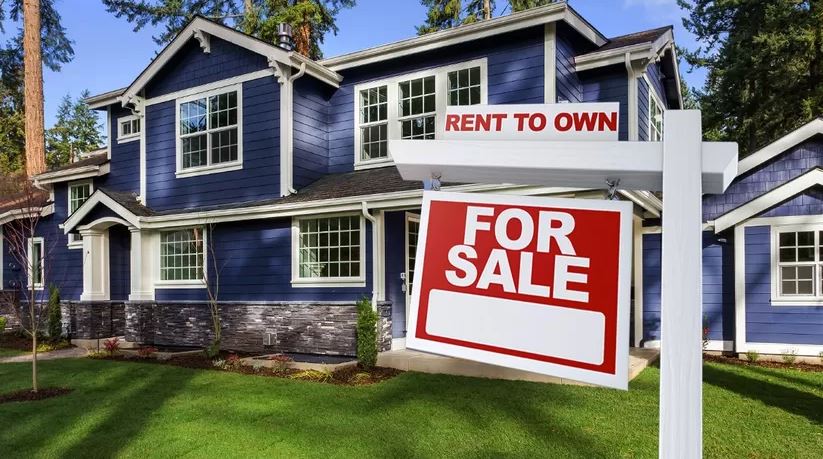
Realtor.com recently covered the rapid rise of rent-to-own housing companies and products. In requiring as little as 1 to 2% down, rent-to-own firms market their products as an alternative for first-time and other homebuyers, who face record-high home prices, high rental prices, and inflation.
Realtor.com notes that while rent-to-own opportunities can help buyers in a competitive housing market, in most cases, people may ultimately pay more than if they bought a home outright, and many never actually close on their homes, despite paying a markup. Analysts caution that evaluating the specifics and risk of each deal is critical for prospective buyers.
For some of these consumers, built-for-rent housing, which has also witnessed considerable growth in recent years, may offer an alternative. Built-for-rent homes offer opportunities to live in a single-family home without high down-payment costs or the small-print risks associated with rent-to-own. The tradeoff? Lack of ownership and equity for the occupant. The SLB is actively tracking the built-for-rent housing segment as an opportunity to increase softwood lumber demand and consumption in the coming years.
Read more from Realtor.com here.
Texas A&M Team Creates New Flame-Retardant Coating for Wood Construction Materials
Researchers from Texas A&M University have developed a new flame-retardant coating for wood construction materials, such as studs and strand boards. The coating can also be used on textiles, polyurethane foam, and 3D-printed materials.
In testing, wood treated with the coating and then burned released less heat and smoke and quickly led to a surface layer of char, thereby protecting the underlying structure. By reducing flame spread and smoke production, the coating can give people more time to evacuate to safety and reduce material damage from fires.
The impact of expanding wildfires has spurred research into promising ideas for new pressure-treated fire retardants. And while the AEC community may welcome innovation from manufacturers, new formulations should be carefully considered against the proven effectiveness, impacts on material strength, and cost of already available solutions.
Read more about the innovation here.
10-Story Mass Timber Building to Undergo Shake Table Testing This Summer
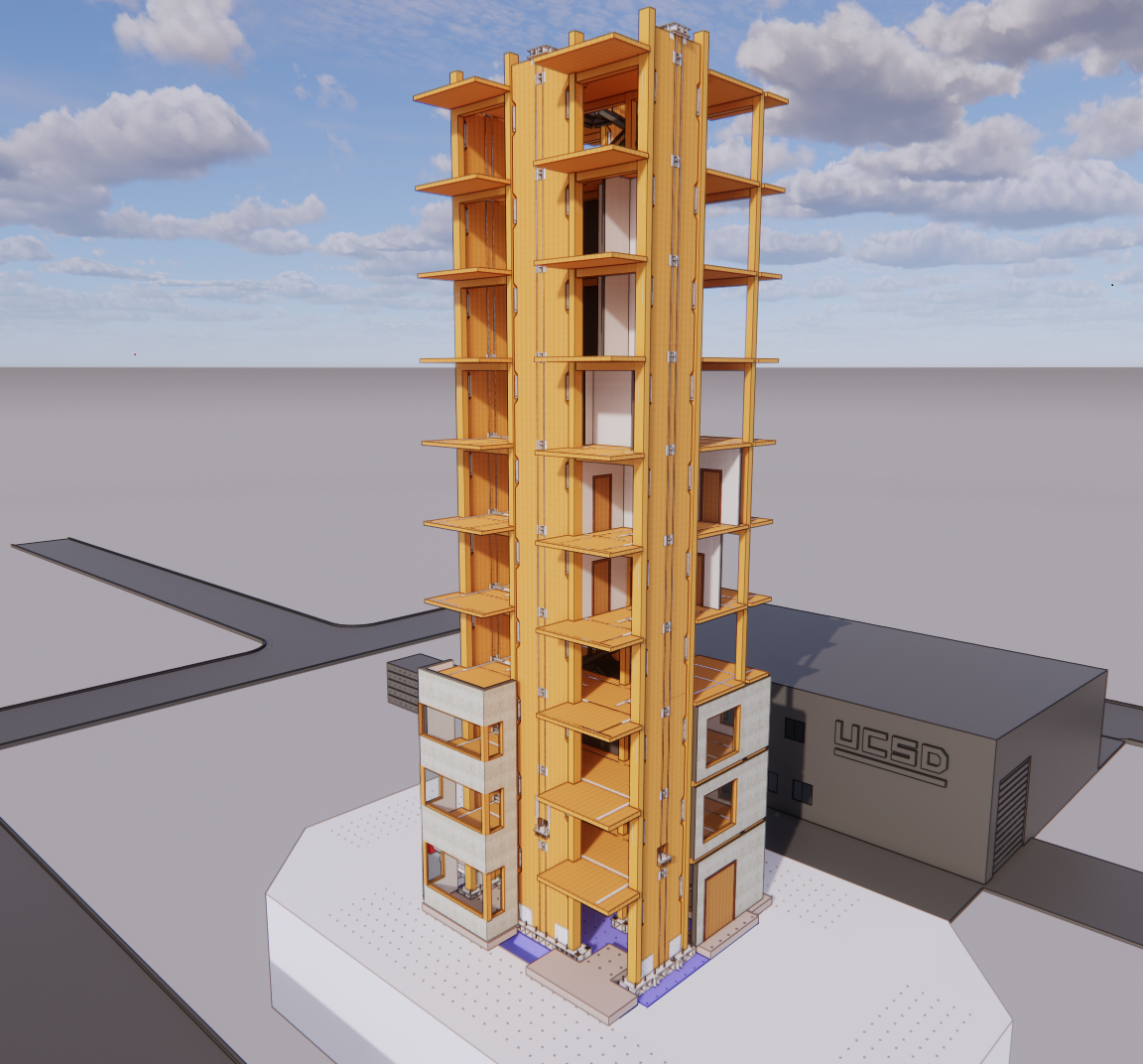
This summer and with support from the SLB and the Binational Softwood Lumber Council, the Natural Hazards Engineering Research Infrastructure (NHERI) TallWood project will simulate an earthquake to test how a 10-story mass timber building withstands seismic forces. The test specimen will be built using a mass timber gravity frame and rocking walls, and it will incorporate nonstructural elements and contents. The test will be conducted on the recently upgraded LHPOST6 shake table at NHERI at the University of California-San Diego. The test specimen will be the world’s tallest full-scale building ever tested.
NHERI is a multidisciplinary research effort, launched in 2016, to test and advance the resiliency of wood construction. It has previously performed shake table tests on two-story mass timber buildings. For this summer’s 10-story test, the research team predicts that the building’s structural system will emerge without damage following multiple design-level simulated earthquakes, proving tall timber’s resiliency during quakes.
Research team member Shiling Pei, from the Colorado School of Mines, also sees the testing as an important public education opportunity, stating: “It will demonstrate the potential benefits of constructing tall buildings out of wood and, with any luck, will also inspire the next generation of engineers and scientists.”
Read more about the upcoming testing here.
Insights on the Competition
New Pulp-Based Stud Enters Commercial Production

ArchDaily examined the importance of innovation in helping the building industry move toward sustainable design and net-zero architecture, including through the use of climate-smart building materials. The piece zooms in on a new product launched by Swedish company Wood Tube—lightweight studs made of wood-based pulp of the type typically found in paper. According to Wood Tube, the studs not only lend themselves to more sustainable construction but also are cost-effective and easy to use in place of wood or steel in various vertical framing applications.
The studs are manufactured in a forest-intensive region of Sweden, fitting easily into the area’s local bioeconomy. Wood Tube studs are both made from sustainably sourced wood fiber and can be recycled like other cardboard. The company’s life cycle analysis shows that Wood Tube studs emit 14 times less CO2 than a steel equivalent. Meanwhile, one tree can result in four times as many paper studs compared with standard wooden options.
Read more about Wood Tube studs here.
Industry Resources
Virginia Tech's Monthly Housing Report
This monthly housing commentary report is a free service of Virginia Tech and is intended to help one gauge future business activity in the U.S. housing market.
February 2022 Reports (released in April 2022)
Part A: February Housing Commentary
Part B: February Economic Conditions


